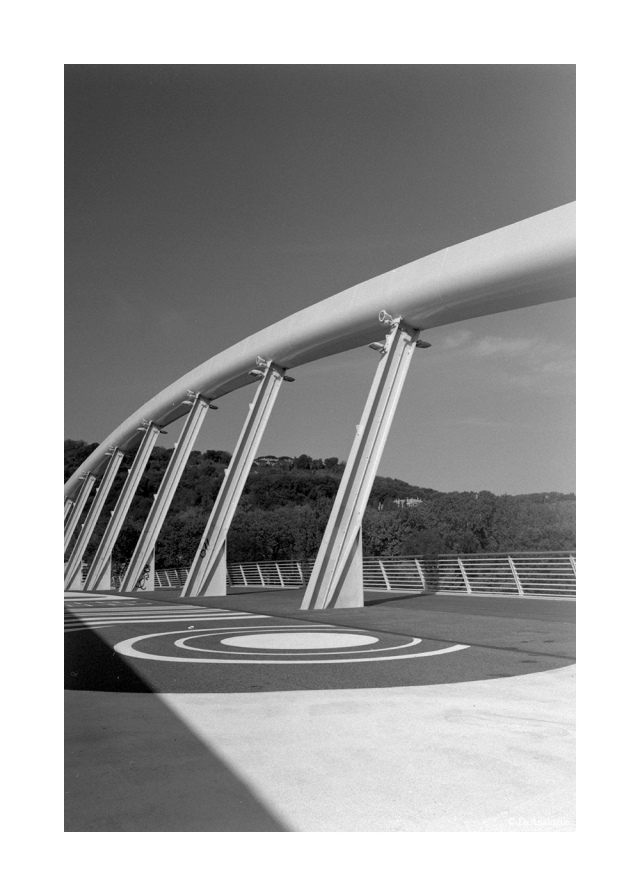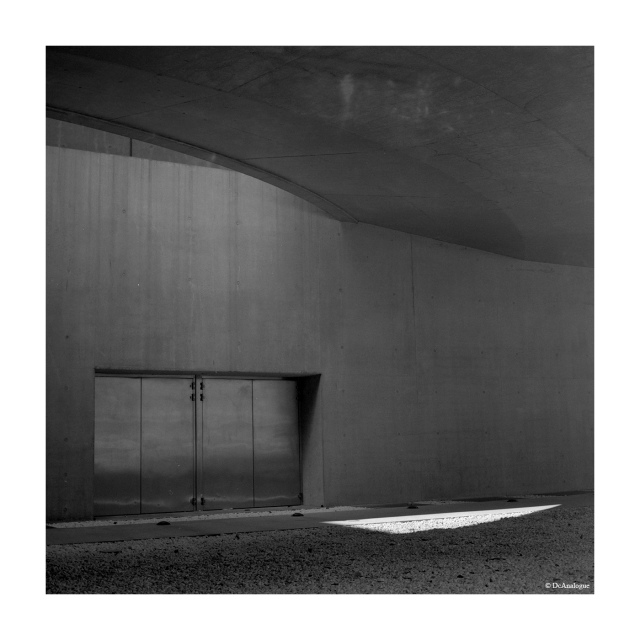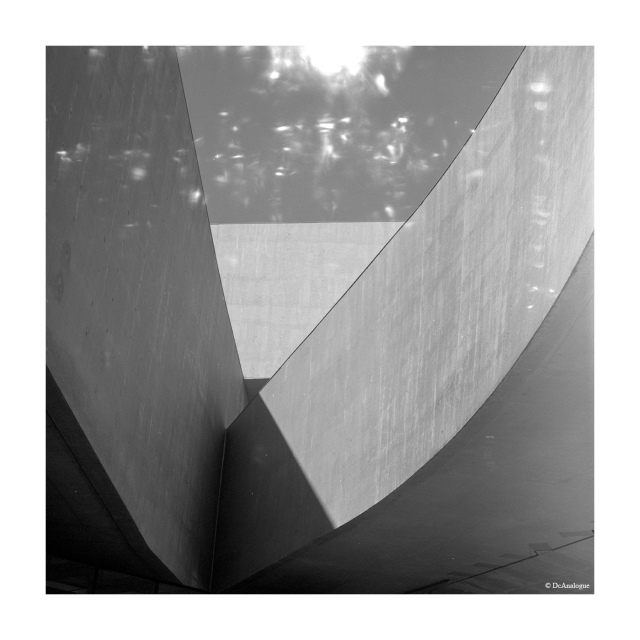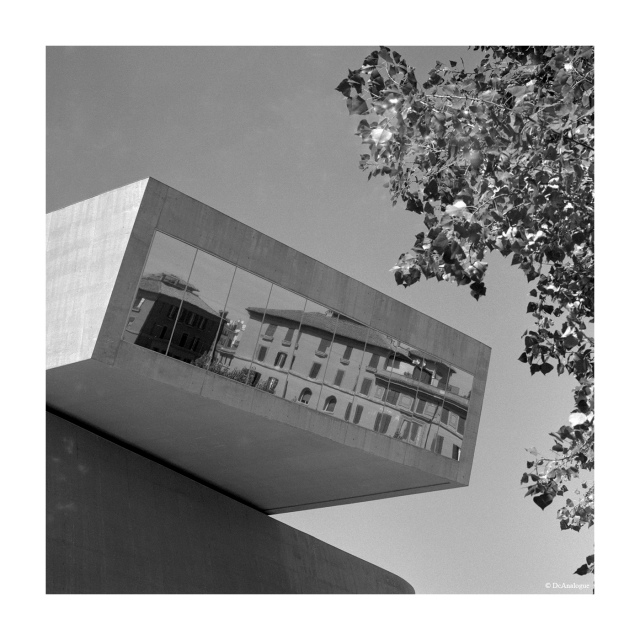
Being (among other things) a fan of cameras and their respectable lenses, made behind the Iron Curtain , long ago I had the opportunity to enrich my vintage “arsenal” with a beautiful Pentacon Six Tl, fitted with its Carl Zeiss Jena Biometar 80mm f/2.8 standard lens, wlf and metered pentaprism with angled eyepiece (and diopter correction). The camera is truly remarkable aesthetic and mechanical conditions, but a first test roll gave so many problems that I thought of having to make another to correct some of my errors in the loading of the film and in the development of the same. In the meantime, I ordered a new focusing screen with split image on Araxfoto site. Following the instructions on the Pentaconsix site (which I highly recommend for any info about these cameras), a few days ago I loaded a Ilford HP5+ film and started my hunting for satisfactory images. But …. things do not always go as we would like …

Braving the sun still hot on a Sunday in September, I finished an entire roll in a few hours and I’ve also started another one (this time a Kodak Trix). Once developed the HP5+ roll I had a bad surprise: I saw that once again, the infamous overlapping frames was still present (so I had to crop many shots), although to a lesser extent than in the first test carried out in the past. This is a well-known problem of the Pentacon Six. The uneven frames spacing may be present on some specimens (especially if loaded incorrectly) more or less frequently and, at times, is impossible to eliminate completely.


A pity, if you think about all the other qualities of this camera and its lenses. Built in the former GDR between the ’50s and ’90s is a medium format (6×6) robust but at the same time, handy and versatile too. The ability to use both the wlf or the pentaprism is in fact very useful depending on the different shooting situations. As mentioned earlier, the dedicated Carl Zeiss Jena lenses got an high reputations and among them there are the Flektogon 50mm f/4 (here used in many shots) and the fantastic Sonnar 180mm f/2.8.





But, to make matters worse the problem of the spacing between frames (though, they have come out 13 frames) … on top of almost all images (especially those in the middle/end of the roll) a myriad of black dots of varying sizes indelibly stained the film. Once scanned the negatives I could see that it could not be a problem due to the development (in Kodak HC 100 dil. H) but rather, some debris that can be done inside during the replacement of the focus screen (?), or to a defect of the film.
Edit: the spots are lightleaks from shutter curtain pinholes.




For the rest, both lenses (as well as film & developer) performed very well, returning the real mood of that beautiful, sunny day.
In some shots (where possible) I totally eliminated, or in part, the spots in post-production. The shots n ° 1, 4, 5, 9, 10, 11, 12, 13 were made with the Biometar. An orange filter was used in shots 5 and 9. It is a plate ( Cokin-like) and cheap chinese filter. As you can see by the images…. seemed to work well. The filter holder was also fitted with a hood. The rest of images was taken with Flektogon, without any filter or hood.
I just finished developing the Trix roll. Stay tuned for the second part of the story ….

(Versione Italiana)
Essendo (tra l’altro) un appassionato di fotocamere d’oltrecortina e delle loro rispettabilissime ottiche, tempo fa ebbi l’occasione di arricchire il mio “arsenale” vintage con un bellissimo esemplare di Pentacon Six Tl, munito del suo Carl Zeiss Jena Biometar 80mm f/2,8, mirino a pozzetto e pentaprisma esposimetrico con oculare angolare (e correzione diottrica). La fotocamera è veramente in condizioni estetiche e meccaniche notevoli ma, un primo rullo di prova ha dato tanti di quei problemi che ho pensato di doverne fare un altro per correggere alcuni miei errori nel caricamento della pellicola e nello sviluppo della stessa. nel frattempo, ho ordinato un nuovo schermo di messa a fuoco, con stigmometro ad immagine spezzata dal sito Araxfoto. Seguendo le istruzioni riportate nel sito Pentaconsix (che raccomando vivamente per ogni notizia riguardante queste fotocamere), pochi giorni fa ho caricato una pellicola Ilford Hp5+ e mi sono messo a caccia d’immagini soddisfacenti. Ma…. non sempre le cose vanno come noi vorremmo…
Sfidando il sole ancora caldissimo di una domenica di settembre ho terminato un intero rullino in poche ore e ne ho iniziato anche un altro (questa volta di Kodak Trix). Una volta sviluppato il rullo di Hp5+ però…. ho visto che anche questa volta, la famigerata sovrapposizione dei fotogrammi era ben presente (per cui ho dovuto croppare molte immagini), anche se in misura minore rispetto al primissimo test effettuato in passato. Questo, è un problema ben noto della Pentacon Six. La spaziatura irregolare dei fotogrammi può presentarsi in alcuni esemplari (specie se caricati in modo scorretto) più o meno frequentemente e, a volte, non si riesce ad eliminare del tutto. Un vero peccato, se si pensa a tutte le altre qualità di questa fotocamera e delle sue lenti. Costruita nell’ex DDR tra gli anni ’50 e ’90 è una medio formato (6×6) robusta ma nello stesso tempo, maneggevole ed anche versatile. La possibilità di utilizzare sia il mirino a pozzetto che il pentaprisma è infatti utilissima a seconda delle diverse situazioni di ripresa. Come già detto, le ottiche Carl Zeiss Jena dedicate sono notevoli e tra esse spiccano il grandangolo Flektogon 50mm f/4 (qui utilizzato in molti scatti) ed il fantastico medio-tele Sonnar 180mm f/2,8.
Ma, come se non bastasse il problema della spaziatura tra i fotogrammi (però, ne sono usciti ben 13)… sulla parte superiore di quasi tutti fotogrammi (specialmente quelli al centro/fine rullo) una miriade di puntini neri delle dimensioni più varie macchiava indelebilmente gli stessi. Una volta scansionati i negativi ho potuto constatare che non poteva essere un problema dovuto allo sviluppo (perfetto, in Kodak HC 100 dil. H) ma piuttosto, a qualche detrito che possa essere finito all’interno durante la sostituzione dello schermo di messa a fuoco (?) oppure, ad un difetto della pellicola.
Edit: le macchie sui negativi sono in realtà infiltrazioni di luce dovute alla presenza di una miriade di microscopici forellini sul terzo inferiore delle tendine dell’otturatore.
Per il resto, entrambe le focali (come pure la pellicola e lo sviluppo) hanno lavorato egregiamente, restituendo perfettamente e piuttosto nitidamente, l’atmosfera della splendida giornata.
In alcuni scatti (ove possibile) ho eliminato totalmente, o in parte, le macchie in post-produzione. Gli scatti n° 1, 4, 5, 9, 10, 11, 12, 13 sono stati realizzati con il Biometar. Un filtro Arancio è stato usato negli scatti 5 e 9. Si tratta di un filtro a lastrina (tipo Cokin) di produzione (economica) orientale. Il portafiltri era munito anche di paraluce. Il resto è stato scattato con il Flektogon, senza alcun filtro o paraluce.
Ho appena finito di sviluppare il rullo di Trix. Stay Tuned per la seconda parte della storia….
Tech Info:
Camera: Pentacon Six Tl – Lenses: Carl Zeiss Jena Biometar 80mm f/2,8 & Flektogon 50mm f/4 – Film: Ilford Hp5+ – Developer: Kodak HC110[H] – Scanner: Epson V550
The frame-overlap with the P6 can have several causes:
a) Film not loaded correctly,
b) film advance handled incorrectly (!),
c) and/or need for CLA.
If you are sure that you mastered a) and b) (there are some videos on YouTube regarding those two points, but the P6 manual gives also the right instructions), and if the spacing problems get less with use (as you describe it), I would think about c) …
(I have a P6TL too, and I had the overlapping frames in exactly two cases: My first roll, that was incorrectly loaded, and trying to use the camera at -9 °C …).
More on the P6 and some special treatments you can find here:
http://baierfoto.de/#english
A very interesting source. I’m thinking about sending a second P6TL (which is not working) to him for his standard CLA. He’s using special lubricants to make it operational in sub-zero conditions, but his CLA is somewhat expensive …
And look out for the Arsenal VEGA-12b 2.8/90 lens – a gorgeous peace of glass (if you can get a good one ;)). For me, this lens beats the Biometar hands down in every regard (especially the 0.6m close-focus distance is very handy and unique for medium format lenses). Look out for those with a *long* aperture pin (some have a short pin on the back, and they do not completely open the aperture when the P6’s shutter is cocked – but this is no real problem for shooting, only for TTL measurement).
Same goes with the Arsenal 2x converter (I have an early Hartblei version). Astonishingly high image quality in combination with the VEGA-12b, even with aperture 4.0 or 5.6 – it looks as if they were made for each other.
LikeLiked by 1 person
Hi, thanks for your hints. I think to have got the point. The black spots are… light leaks from the shutter curtain and taking a better look to my second roll (developed yesterday) I think that more than bad spacing it’s a shitter problem… So, I’ll send it for a Cla and shutter curtain replacement to my repairman….. 😉
LikeLike
A, well, light leaks – I wouldn’t have thought of that: Quite unusual for an SLR camera, but what I forgot is that the mirror does not return after the shot and therefor exposes the shutter curtain(s) to sunlight through the lens (a big problem with rangefinder cameras like the Leica models; no problem with leaf shutter cameras, though ;)).
The P6TL is worth it. A little bit heavy, but the moment it works as it should, it has its advantages over much more elaborate cameras!
(Hihi, and the VEGA-12b is a gorgeous *piece* of glass – has nothing to do with the lack of war, even though the Ukraine could do with some peace int eh Donbas region. I still have a problem with homophones in English, as it looks … ;))
LikeLiked by 1 person
I always charged the shutter after a shot but we must consider that I was using a 400 Iso in avery bright sunny day…. 😉
LikeLike
Thinking of the mirror not returning: I always do film transport after the shot, so my P6 should be fine if exposed to sunlight …
LikeLiked by 1 person
Yeah, what I meant is that with the mirror in place there is no risk of burning holes into the shutter curtain by accidentally having the sun shining into the lens (e.g. when having the camera placed somewhere in a sunny place – what a former user of your camera might have been done).
LikeLiked by 1 person
Some very nice pictures despite the errors you encountered. I have a soft spot for the P Six but it is a troubled camera also in my experience. I got one as a gift from a friends mom in late high school times with the 80/2.8 and 180/2.8. The body did not work so gave it to a shop to repair (back in the 90s you had a good choice of camera repairmen …) but even after repair it was a “diva”. The spacing between frames was always uneven so I only took every second frame to be sure to have no overlapping at all. The shutter times were never accurate.
Some years later the shutter got sticky, so almost every second shot was ruined … eventually I sold the camera to a guy who wanted to do astro photography and did not care as he only needed the Bulb setting anyway.
I still like it somehow. 🙂
Cheers, Thomas
LikeLiked by 1 person
Well, I like very much this camera too… It’s very nice and esy to use and lenses are really very good. Actually is on repair and hope to have it back working well. If not, I’ll sell it back to the vendor and buy maybe a Kiev 60 or so…. 😉
LikeLike